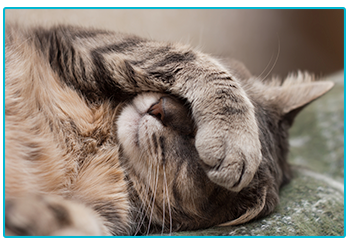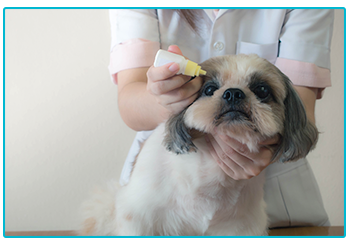
Most people are familiar with how fantastic our dogs and cats hearing and sense of smell can be! What we might forget is, although different to our own, their eyesight is just as important. One condition that can affect the eyes of our furry friends are corneal ulcers. At The Insurance Emporium, we like to stay on top of anything that can cause problems for our felines and canines. That’s why we spoke to our pet health expert to create this guide to corneal ulcers in pets!
What are corneal ulcers?
The cornea is the clear surface layer covering the eye, and an ulcer is an injury to this surface. As with any other wound, corneal ulcers can vary in both size and depth. If left untreated, they can cause much discomfort, potentially leading in severe cases to loss of vision in the affected eye.

How can they develop?
The most common cause is trauma, whether blunt, such as grazing the eye against a carpet, or more acute, like a scratch. They might also develop due to abnormalities affecting the eyelids, problems with tear production, or as a result of bacterial, fungal or viral infections.
How can you recognise the symptoms?
The signs that your pet has developed a corneal ulcer can be simple to spot. They might keep rubbing the affected eye, squint, blink more frequently, show sensitivity to bright light, act depressed and off their food. Other symptoms could also present, such as redness of the white of the eye, a discharge and changes to the appearance of their eye, such as blood vessels or a blue/white opacity.
What should you do?
As with any concern you might have about your pet’s health, the best course of action would be to contact your vet. They will then carry out an examination, using a fluorescein stain to detect any defects. The stain will make the eye an orange colour, allowing abrasions to be seen under a blue light.

How is it treated?
Treatment for corneal ulcers in pets will depend upon the severity. If mild, the ulcer could be treated with eye drops and other medications. More severe cases might require surgery to be removed. If the pet in question has any underlying health issues that could have led to the ulcer, these will also need to be addressed to help prevent the same problem happening again.
If you suspect your dog or cat might have any kind of problem with their eyes, it’s always wise to get in touch with your local vet. As with any other condition, early detection and treatment of corneal ulcers could see your four-legged friend back on top form in no time!
All content provided on this blog is for informational purposes only. We make no representations as to the accuracy or completeness of any information on this site or found by following any link on this site. We will not be liable for any errors or omissions in this information nor for the availability of this information. We will not be liable for any loss, injury or damage arising from the display or use of this information. This policy is subject to change at any time.


